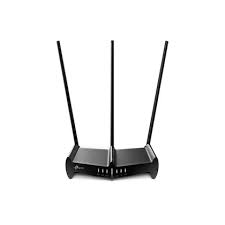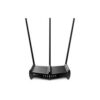TP-Link TL-WR941HP 450Mbps High Power Wireless N Router
TP-Link TL-WR941HP 450Mbps High Power Wireless N Router delivers extended wireless coverage through amplified transmission power and advanced 3×3 MIMO technology, providing reliable internet access across larger homes and challenging environments where standard routers struggle to maintain consistent connectivity. This high-performance Wireless N router operates on the 2.4GHz frequency band with enhanced signal strength, reaching areas that conventional routers cannot serve effectively while supporting speeds up to 450 Mbps.
Unlike basic 300 Mbps routers limited by standard antenna configurations, this high-power design combines three transmit and three receive antennas with boosted RF output to maximize both speed and coverage range. The router extends wireless service by approximately 40-60% compared to typical Wireless N routers, making it particularly valuable for users who prioritize comprehensive coverage over the latest wireless standards but still require solid performance for modern internet activities.
High Power Transmission and Enhanced Range Technology
Advanced MIMO Architecture and Signal Amplification
The TP-Link TL-WR941HP 450Mbps High Power Wireless N Router optimizes wireless performance through sophisticated antenna design:
- 3×3 MIMO configuration: Three independent data streams provide 450 Mbps theoretical speeds with improved reliability
- High-gain external antennas: Three 9dBi antennas focus and amplify wireless signals for maximum penetration
- Enhanced transmission power: Boosted RF output within regulatory limits delivers stronger signals to distant devices
- Spatial diversity: Multiple antennas reduce dead zones and improve signal consistency throughout coverage area
Coverage Performance and Penetration Capabilities
Real-world testing demonstrates significant range improvements over standard wireless routers:
- Extended home coverage: Effective wireless service across homes up to 3,000 square feet
- Multi-story performance: Strong signal transmission through floors and between building levels
- Obstacle penetration: Enhanced power maintains connectivity through concrete walls, metal structures, and multiple barriers
- Outdoor extension: Reliable coverage extends to garages, workshops, and covered outdoor areas up to 150 feet from router
450 Mbps Wireless N Performance and Speed Distribution
Enhanced Wireless N Technology
Advanced 802.11n implementation provides superior performance compared to basic Wireless N routers:
- 450 Mbps maximum speed: Triple-stream configuration delivers 50% more bandwidth than standard 300 Mbps routers
- 40 MHz channel bonding: Wide channels double available bandwidth compared to 20 MHz operation
- Advanced modulation: Higher-order signal encoding maximizes data throughput
- Backward compatibility: Full support for 802.11g and 802.11b legacy devices
Real-World Throughput Expectations
Practical performance varies based on distance, interference, and environmental conditions:
- Close-range performance: 200-300 Mbps typical speeds within 50 feet with clear line-of-sight
- Medium-distance operation: 100-200 Mbps at 75-100 feet through standard interior construction
- Extended range connectivity: 50-100 Mbps at coverage boundaries where other routers provide no service
- Multi-device handling: Stable performance supporting 15-20 simultaneously connected devices
Advanced Router Features and Network Management
Professional Networking Capabilities
The TP-Link TL-WR941HP 450Mbps High Power Wireless N Router includes sophisticated features for home and small business use:
- Quality of Service (QoS): Intelligent bandwidth allocation prioritizes gaming, streaming, and VoIP traffic
- Guest network support: Separate wireless network for visitors with bandwidth and access controls
- Parental controls: Time-based internet restrictions, website filtering, and device management
- Access control: MAC address filtering and device-specific connection permissions
Security Features and Network Protection
Comprehensive wireless security protects against unauthorized access and threats:
- WPA2 encryption: Advanced wireless security with AES encryption protocols
- WPS connectivity: Secure one-button setup for compatible devices
- Firewall protection: SPI firewall with DoS attack prevention and intrusion detection
- VPN pass-through: Support for PPTP, L2TP, and IPSec secure connections
Physical Connectivity and Port Configuration
Wired Network Integration
Ethernet ports support various networking requirements while wireless provides extended coverage:
- Fast Ethernet WAN port: 100 Mbps connection to cable, DSL, or fiber internet services
- Four Fast Ethernet LAN ports: Wired connections for gaming consoles, desktop computers, and network devices
- Auto-negotiation: Automatic speed detection and configuration for optimal wired performance
- Link status indicators: LED confirmation of active connections and network activity
Antenna Design and Positioning
External antenna configuration maximizes signal distribution and strength:
- Three detachable antennas: High-gain 9dBi antennas with adjustable positioning
- Omnidirectional coverage: 360-degree signal distribution with focused beam enhancement
- Manual positioning: Adjustable antenna angles optimize coverage for specific layouts
- Antenna upgrade compatibility: Standard RP-SMA connectors allow antenna replacement if needed
Ideal Applications and Target Environments
Large Home and Ranch-Style Properties
The router’s extended range capabilities address specific residential challenges:
- Single-story sprawling homes: Comprehensive coverage across wide ranch-style floor plans
- Multi-level houses: Reliable connectivity between floors and to basement/attic areas
- Challenging construction: Homes with log, brick, or concrete construction requiring signal penetration
- Property extensions: Coverage to detached garages, workshops, and outdoor entertainment areas
Small Business and Commercial Applications
Professional environments benefit from reliable extended wireless coverage:
- Retail establishments: Customer and employee connectivity throughout store areas and back offices
- Small office spaces: Reliable internet access across multiple rooms and work areas
- Warehouse operations: Extended coverage for inventory systems and mobile device connectivity
- Restaurant and hospitality: Guest Wi-Fi coverage throughout dining and common areas
Setup Process and User Interface
Installation and Configuration
The TP-Link TL-WR941HP 450Mbps High Power Wireless N Router provides multiple setup options:
- Web-based setup wizard: Browser interface guides through internet and wireless configuration
- TP-Link Tether mobile app: Smartphone-based installation and ongoing network management
- WPS button setup: One-touch wireless device connection for compatible equipment
- Quick installation guide: Step-by-step instructions accommodate non-technical users
Advanced Management Interface
Comprehensive controls provide detailed network oversight and optimization:
- Real-time monitoring: Connected device tracking, bandwidth usage, and network status
- Wireless optimization: Channel selection, power adjustment, and signal analysis tools
- Advanced settings: Manual configuration options for power users and specific requirements
- Firmware updates: Automatic and manual update options ensure security and performance
Performance Optimization and Environmental Factors
Maximizing High-Power Benefits
Several strategies enhance the router’s extended range capabilities:
- Optimal placement: Central positioning maximizes omnidirectional coverage benefits
- Antenna orientation: Proper antenna positioning focuses signals toward primary usage areas
- Interference mitigation: Distance from microwaves, cordless phones, and metal obstacles
- Channel optimization: Manual channel selection avoids congested frequencies in dense areas
Environmental Considerations and Limitations
Understanding factors that impact wireless performance helps set realistic expectations:
- Power regulations: High-power operation must comply with regional RF emission limits
- Heat management: Enhanced transmission power generates additional heat requiring ventilation
- Interference sensitivity: 2.4GHz operation subject to interference from household devices
- Neighbor network impact: Performance affected by competing wireless networks in residential areas
Energy Consumption and Operating Specifications
Power Requirements and Efficiency
High-power operation involves specific energy and thermal considerations:
- Increased power consumption: Enhanced transmission requires additional electrical usage
- Heat dissipation: Higher power output produces more heat requiring adequate cooling
- Continuous operation: 24/7 usage contributes to household energy consumption
- Thermal protection: Automatic power reduction prevents overheating damage
Operating Environment and Installation Requirements
- Temperature tolerance: Operates effectively in typical home and office environments (0°C to 40°C)
- Humidity specifications: Suitable for standard indoor humidity levels (10% to 90% non-condensing)
- Ventilation needs: Adequate airflow prevents thermal throttling during peak operation
- Physical mounting: Desktop placement or wall mounting with included hardware
Limitations and Technology Considerations
Wireless N Technology Constraints
The TP-Link TL-WR941HP 450Mbps High Power Wireless N Router operates within specific boundaries:
- Single-band operation: 2.4GHz only, lacking 5GHz band for interference avoidance
- Older wireless standard: 802.11n technology superseded by AC and AX standards
- Fast Ethernet ports: 100 Mbps wired connections may limit very high-speed internet services
- 2.4GHz congestion: Performance degrades in areas with many competing wireless devices
When to Consider Alternative Solutions
Different router technologies may provide superior performance for specific requirements:
- Dual-band needs: AC routers offer 5GHz band with reduced interference and higher speeds
- Gigabit internet: Modern routers with gigabit ports support faster internet connections
- Wi-Fi 6 technology: 802.11ax routers provide advanced efficiency features and futureproofing
- Mesh networking: Whole-home systems offer superior coverage for very large or complex layouts
Cost-Effectiveness and Value Analysis
High-Power Wireless N Investment
This router provides specific value for coverage-priority applications:
- Range-focused solution: Optimal for users prioritizing coverage over cutting-edge speed
- Cost-effective coverage: Less expensive than mesh systems while providing extended range
- Proven technology: Mature 802.11n standard offers reliable performance and broad device compatibility
- Single-device solution: Eliminates need for range extenders or additional access points
Long-Term Technology Relevance
Understanding the router’s position within evolving wireless standards:
- Wireless N longevity: 802.11n remains functional despite newer standard availability
- Coverage value retention: Extended range benefits continue regardless of speed standard evolution
- Internet speed matching: Adequate for most current residential broadband services
- Replacement timeline: 3-5 year useful life before newer technologies provide compelling advantages
Installation Environment and Optimal Conditions
Physical Placement Strategies
Router positioning significantly impacts high-power transmission effectiveness:
- Central elevation: Higher placement improves signal distribution throughout coverage area
- Clear sight lines: Unobstructed paths to primary usage areas maximize performance
- Interference avoidance: Distance from competing electronics enhances signal quality
- Ventilation access: Adequate cooling prevents performance degradation from overheating
Network Infrastructure Integration
- Internet service compatibility: Optimal with broadband plans up to 300-400 Mbps
- Device ecosystem: Works with all Wi-Fi enabled devices regardless of manufacturer
- Legacy support: Backward compatibility ensures older devices maintain connectivity
- Future expansion: Can serve as primary router or access point in larger network deployments
Maintenance and Support Considerations
Ongoing Device Management
Regular maintenance ensures continued optimal performance:
- Firmware monitoring: Updates improve security, compatibility, and performance
- Performance assessment: Periodic speed tests identify potential optimization opportunities
- Antenna maintenance: Occasional cleaning and positioning adjustment optimize coverage
- Ventilation inspection: Ensuring adequate cooling prevents thermal performance issues
Technical Support and Resources
TP-Link provides comprehensive support for high-power router deployments:
- Installation documentation: Detailed guides for optimal placement and configuration
- Troubleshooting resources: Common issue resolution and performance optimization techniques
- Community support: User forums with configuration tips and problem solutions
- Warranty coverage: Standard manufacturer protection against hardware defects and failures


 No products in the cart.
No products in the cart. 
Reviews
There are no reviews yet.